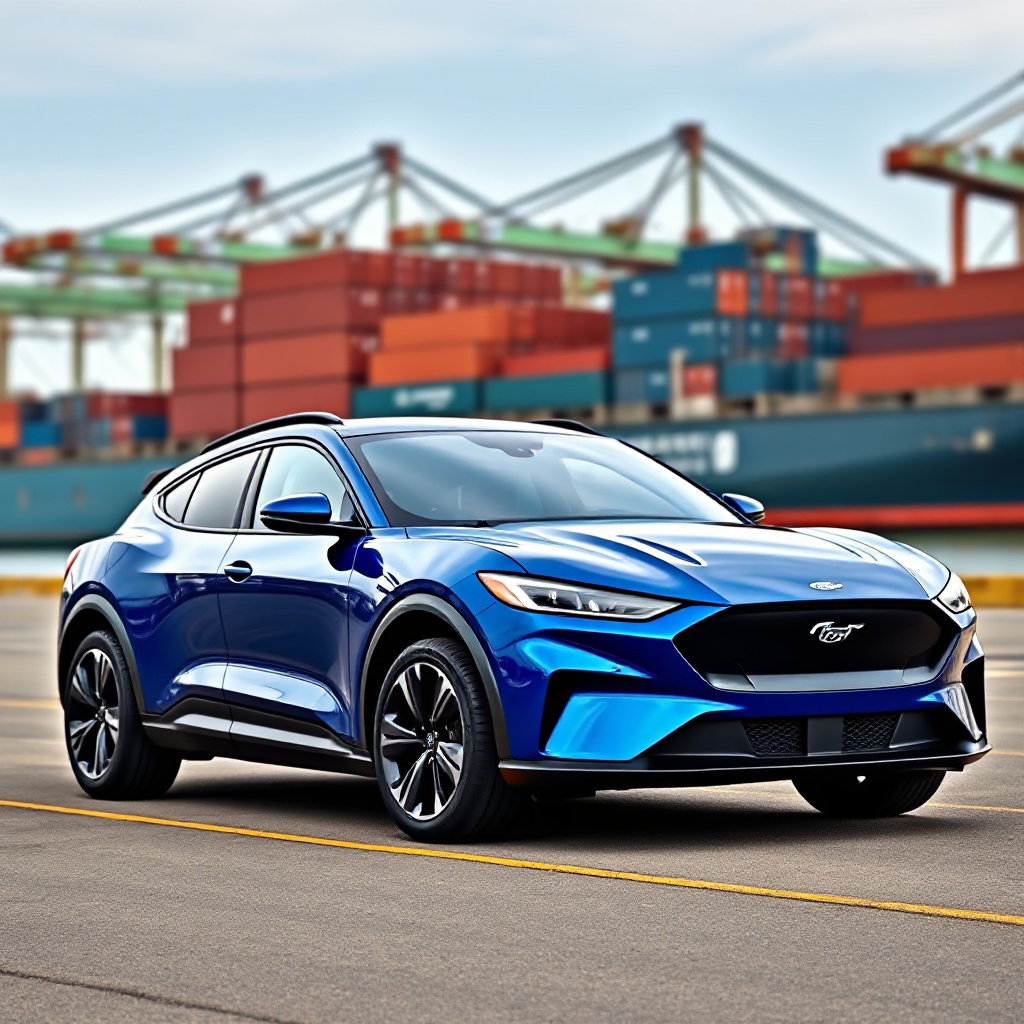
US auto industry faces 25% import tariffs, pushing Ford to raise prices while their EV division soars with Mach-E sales up 21% amid complex market challenges.

Drivetech Partners
The U.S. automotive industry is experiencing unprecedented upheaval as new 25% tariffs on imported vehicles and parts take effect, forcing manufacturers like Ford to implement price increases across their lineups. Despite the pricing pressures, Ford's electric vehicle division shows remarkable resilience with the Mustang Mach-E posting a 21% sales increase in Q1 2025, highlighting the complex balancing act between tariff-driven price hikes and maintaining growth in evolving market segments.
Key Takeaways
New 25% import tariffs implemented April 2025 have disrupted North American free trade agreements and caused industry-wide price increases
Affordable vehicles under $30,000 are disproportionately affected, with nearly 80% facing significant price hikes
Ford's overall sales declined 6.3% in early 2025, while their EV division grew 21% in the same period
Hybrid vehicle sales have outpaced even EV growth, rising 33% in Q1 2025
Complex global supply chains face severe disruption as parts crossing borders multiple times incur compounding tariff costs
Tariff Shock: Ford Raises Prices Amid Sweeping Import Duties
The automotive industry faces a seismic shift following the implementation of sweeping 25% tariffs on imported automobiles and parts, which took effect on April 3, 2025. These new duties have effectively dismantled the long-standing free trade agreements across North America, with tariffs on Canadian and Mexican imports now subject to monthly negotiation, creating unprecedented market uncertainty.
The impact extends beyond North American trade partners, with tariffs on Chinese automotive imports doubling from 10% to 20%. These changes have forced manufacturers, including Ford, to pass costs on to consumers through significant price increases across their model lineups.
Industry analysts project that vehicles directly impacted by tariffs will see price increases of 10-15%, while even models not subject to the full 25% tariff will likely experience price hikes of at least 5%. This pricing pressure comes at a time when the average vehicle prices are already hovering near all-time highs, further squeezing affordability for many consumers.
Price Hikes Hit Affordable Vehicles Hardest
The tariff impact falls disproportionately on the affordable vehicle segment. Lower-priced vehicles (under $40,000) are particularly vulnerable, representing 40% of 2024 new-vehicle sales by volume. The situation is even more dire for the most affordable options, with nearly 80% of vehicles priced under $30,000 affected by the 25% tariff.
To put this in perspective, a 25% duty on an average $25,000 landed cost from Mexico or Canada adds $6,250 to the vehicle cost - a significant jump that fundamentally alters the economics of affordable transportation. Popular budget-friendly models affected include the Honda Civic, Toyota Corolla, Chevy Trax, and Nissan Sentra.
Compact SUVs, which have become the backbone of many manufacturers' lineups, are also significantly impacted. Models like the Toyota RAV4, Honda CR-V, and Nissan Rogue face substantial price increases, limiting options for consumers seeking practical, affordable transportation.
Ford's Mixed Performance: Traditional Models Struggle While EV Sales Surge

Ford's recent performance tells a tale of two companies. The automaker's overall sales fell by 6.3% in January 2025, with 191,531 units sold across Ford and Lincoln brands. This decline continued through February, resulting in a year-to-date decline of 7.7%, trailing 2024 output by more than 25,000 units.
Traditional gasoline models have shown particular weakness, with gas-powered Mustang sales dropping a concerning 34% in early 2025. The luxury Lincoln division hasn't fared better, with sales declining 14.6% overall and all models showing decreases ranging from 9.6% (Nautilus) to over 26% (Aviator).
However, not all segments are struggling. F-Series truck sales increased 17.3% so far in 2025, bucking the downward trend and demonstrating the continued strength of Ford's flagship product line. Nevertheless, Ford joins other major manufacturers in passing tariff costs to consumers despite these sales challenges.
Mustang Mach-E Leads Ford's Electrification Surge

While traditional models face headwinds, Ford's electric vehicle division shows remarkable momentum. The Ford Mustang Mach-E has emerged as a standout performer, with sales increasing 21% in Q1 2025, totaling 11,607 units sold.
January 2025 alone saw 5,666 EVs sold, marking a 21.2% increase year-over-year. The Mach-E accounted for 3,529 of these units - a staggering 173% increase from January 2024. This performance has established the Mach-E as the second-best-selling electric SUV in the US, behind only the Tesla Model Y.
The 2025 Mach-E offers impressive specs to match its sales success, featuring 250-280 miles of range in standard configurations. Performance enthusiasts can opt for GT and Rally trims delivering up to 480 horsepower, with 0-60 mph acceleration under 4.0 seconds - quicker than V-8 Mustang models. Maximum range reaches 320 miles with the single-motor rear-wheel-drive and Extended battery pack configuration.
Ford's commercial EV offerings also show strength, with E-Transit electric van sales rising 30%, totaling 3,756 units in Q1. This comprehensive EV growth occurs despite the challenging tariff environment, suggesting strong underlying demand for Ford's electric offerings.
Hybrids Outpace Even EV Growth
While Ford's EV growth is impressive, hybrid sales have shown even stronger momentum. Hybrid sales increased significantly - up 23.5% through February 2025, with total hybrid sales rising 33% in Q1. The F-150 hybrid specifically matched this growth rate with a 33% increase.
The Ford Maverick has emerged as a particular success story, becoming America's best-selling hybrid pickup with 21,414 sales. This strong performance across hybrid models suggests consumers are seeking fuel efficiency amid economic uncertainty, while still preferring the compromise between efficiency and affordability that hybrids offer compared to full EVs.
Ford's strategy of positioning hybrid options as bridge technology during the market transition appears to be paying dividends. This approach provides consumers with more affordable efficiency options while the EV ecosystem continues to mature and potentially helps insulate the company somewhat from tariff pressures.
Supply Chain Chaos: The Hidden Cost of Tariffs
Beyond the direct pricing impact, the new tariffs have created unprecedented supply chain disruptions. Modern automotive manufacturing relies on complex global supply chains, with vehicles often developed in one country, components produced in others, and final assembly happening elsewhere.
The integrated North American automotive market is particularly affected. Canadian suppliers alone operate 156 production sites across 19 US states. Car parts may cross the US-Canada border up to eight times before final assembly, with each border crossing now subject to additional customs duty, drastically increasing production costs.
This disruption creates cascading effects throughout the supplier network. Some suppliers may invoke Force Majeure, refusing to supply parts without compensation for tariff costs. Smaller tier 1 and tier 2 suppliers lack the capital to cover ongoing tariffs without OEM support, creating bottlenecks in the supply chain.
Electric vehicle manufacturers face particular challenges from these supply chain disruptions due to their reliance on global sourcing for rare materials. The complexity of EV supply chains, combined with the specialized nature of many components, makes them especially vulnerable to trade disruptions.
Manufacturing Relocations and Job Impact
One stated goal of the tariffs is to promote domestic automotive production by encouraging relocation to the US. German manufacturers producing vehicles in Mexico for the US market face considerable pressure to shift production, potentially creating manufacturing jobs in the US.
However, this potential benefit comes with significant complications. Production relocations could lead to job losses in Canada and Mexico, potentially destabilizing the integrated North American automotive ecosystem. Market uncertainty has caused manufacturers to become more cautious in planning, with investments likely to be deferred due to the unpredictable trade situation.
Compounding these challenges is the lack of clear metrics for tariff removal. With no established benchmarks for when tariffs might be lifted, manufacturers face difficult decisions about long-term capital investments, especially for plants and tooling with 5-10 year planning horizons.
Ford's pricing strategy aims to balance maintaining market share while covering increased costs. While passing some costs to consumers is inevitable, the company must avoid pricing vehicles out of their target segments, especially in the increasingly important affordable EV and hybrid categories.
Long-Term Industry Outlook
The automotive industry faces an uncertain future as it adjusts to this new tariff reality. Additional costs will likely continue to be passed on to consumers, potentially decreasing overall demand in a market already strained by high prices. Consumer preferences may shift toward domestic-made vehicles to avoid tariff costs, creating winners and losers among manufacturers based on their production footprint.
Market uncertainty continues to hinder long-term investment planning across the industry. The EV adoption trajectory may be affected by price increases despite growing demand, potentially slowing the transition to electric mobility. Manufacturers face the challenging balance between protecting margins and maintaining sales volume in this complex environment.
Ford's strategy of embracing both EVs and hybrids provides flexibility amid this uncertain trade environment. This dual approach allows the company to target different consumer segments and respond to shifting market conditions. If tariffs remain in place long-term, there may be significant opportunities for domestic manufacturing expansion, though the transition period will likely be turbulent for both manufacturers and consumers.
For consumers, the immediate future means higher prices across most vehicle segments, with affordable models disproportionately affected. The long-term implications for vehicle availability, pricing, and manufacturing locations will continue to evolve as the industry adapts to this new trade landscape.
Sources
White House - Amendments to Adjusting Imports of Automobiles and Automobile Parts




